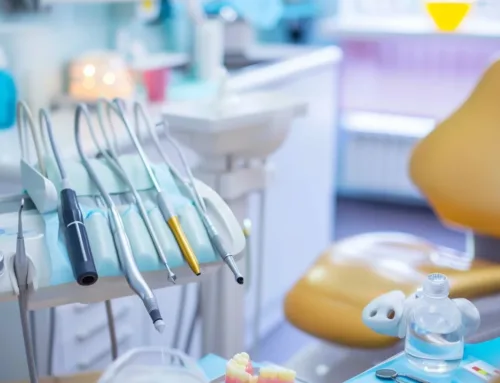Properly Dealing with Broken Dental Bridges & Crowns
A broken dental crown or damaged dental bridge can be a serious oral health issue and should be dealt with as quickly as possible. In this article, we explain how to handle these types of issues, and what factors can cause them.
Dental bridges and dental crowns are durable and effective solutions for addressing a wide range of oral health issues and can last for decades if cared for properly. Ultimately, however, they are not indestructible solutions and may eventually need to undergo some form of repair or replacement procedure.
In some cases, there may be a premature need for repair or replacement if the bridge or crown becomes damaged or broken due to an accident or due to some other type of dental health problem. If this happens, it’s very important that the problem is addressed quickly in order to prevent the damaged bridge or crown from progressing into a more severe dental health situation.
What Can Cause Damage to a Dental Bridge or Dental Crown?
There is more than one way that dental bridges and crowns can become damaged, broken, or loose in the mouth and require repair or replacement. The most obvious of these is a sudden or accidental impact to the mouth. With enough force, an impact can cause a dental bridge or crown to crack, break, become loose, or even become fully dislodged. Even less severe impacts or direct pressure, if frequent or constant, can cause loosening of a crown or bridge.
If there has not been any such accident or impact to the mouth or jaw, then it’s possible that decay on the teeth that are supporting the bridge or crown may be the cause. As these two types of dental appliances rely on a sturdy, solid base of natural teeth to support them, tooth decay on these teeth can cause the structural integrity of the bridge or crown to be compromised. Intermittent or irregular dental hygiene habits can exacerbate this problem and cause decay at a more rapid pace and make the crown or bridge more likely to require repairs sooner.
Depending on the cause of damage to a bridge or crown that you are faced with, there may be varying degrees of urgency to the situation. In some cases, you will need to take immediate emergency action, whereas in other situations you may have more time to make scheduled arrangements to correct the problem.
Are Broken Bridges and Crowns Dental Emergencies?
If you’re unsure whether a broken dental bridge or damaged dental crown really constitutes a dental emergency, simply think about the scope of the damage, the cause of the problem, and the other effects that are being experienced.
For example, in the event of an accidental impact to the jaw that causes severe pain, lacerations, bleeding, sudden headaches, lost teeth, or other intense symptoms that show no sign of subsiding, then you should take emergency action immediately.
For situations that are life-threatening, you should call 911.
For non-life threatening emergencies, you can contact your dentist’s emergency services number or proceed to your nearest hospital emergency room for urgent care. Another option for guidance is to contact Telehealth Ontario, and they can help you determine the best course of action.
Even if the situation is not deemed to be a serious emergency, you should still act as quickly as possible to minimize the risks of further damage or progression of the condition to a more serious state. In any event of damage to a dental bridge or dental crown, contact your dentist and make an appointment at the earliest possible time. If left untreated, a cracked or damaged dental appliance can continue to develop long-term problems and more serious effects to your overall dental health, so it’s always best to act fast.
What To Do If Your Dental Bridge or Dental Crown is Broken or Loose
If you discover that damage has occurred to a dental bridge or dental crown in your mouth, the first thing to do is to avoid making the problem any worse by not putting any pressure on the area and by not chewing on the affected area. Take a moment and look closely in a mirror to try and determine how extensive the damage is. Check to see if there are cracks, chips, or missing pieces of the crown or bridge. Gently probe the area with your finger to feel for any looseness or damage that you can’t visibly see, but do not attempt to push it or pull it off if you feel that any part is loose.
Make a call to your dentist at the earliest opportunity and describe the situation to them in as much detail as possible, including any information you have on the extent of the damage and how the damage may have occurred. For example, if you first noticed something was wrong after an accidental impact to your jaw, or perhaps while you were recently eating something, this information will be helpful to your dentist.
In the event that pieces of the bridge or crown have broken off, or if the entirety of it has come all the way off of the teeth it was mounted to, ensure that you retain these pieces and bring them with you to your dentist. Examination of these pieces can help provide more information on what happened and why.
How Are Broken or Damaged Bridges and Crowns Fixed?
The method used to solve the problem of a broken or damaged bridge or crown is determined by the extent of the damage and the condition of the surrounding teeth. In some cases, a simple crack or chip of a bridge or crown may be able to be fixed with a dental bonding material in order to fill in the gaps and restore the strength and shape of the bridge or crown. Sometimes a loose bridge can be removed and re-cemented in place if the supporting teeth are still in ideal condition.
In cases of more extensive damage, or in cases where the supporting teeth have experienced decay or degradation over the years, the bridge or crown may need to be replaced with a new version better suited to the current condition of your dental health. Supporting teeth that are showing signs of decay may have changed shape over time, and no longer fit perfectly with the shape of your old crown or bridge. This situation would require repair work to be done on the supporting teeth and a new dental appliance to be created to precisely fit the repaired teeth.
Your dentist will recommend the best course of action for you based on the type of damage that occurred and the current condition of your dental health and will work to perform the repair as soon and efficiently as possible in order to restore full mouth function and get you back to your normal life again.
What Can I Do To Prevent Damage or Failure of a Dental Bridge or Crown?
While accidents can always happen, there are preventive steps you can take to help keep your dental bridge or crown work as strong and secure as possible. Following a sensible oral health care routine at home is essential, with regular brushing, flossing, and oral rinses to help keep your teeth and gums healthy and resilient.
In addition, you should always keep up with your scheduled dentist visits and have open and honest discussions with your dentist and hygienist about your dental health concerns. They will be glad to provide guidance and recommendations on any other things you can do to maintain a strong and healthy mouth.
If you currently have a loose or damaged dental bridge or dental crown, we strongly urge you to contact us today to arrange for an appointment at the earliest opportunity. We are here to help and can accommodate after-hours and emergency appointments as well.
Appointment Request
If you’re interested in any of our procedures, and would like to meet with one of our dentists to discuss options, costs and get additional information, complete this short form and we’ll give you a call to arrange for a no-obligation appointment at our Barrie clinic.










